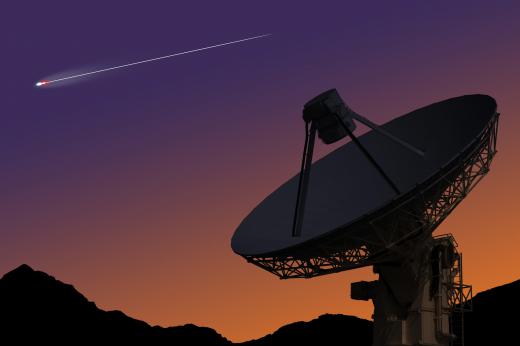Which Electromagnetic Wavelengths can Pass Through the Atmosphere?
 Michael Anissimov
Michael Anissimov
The vast majority of electromagnetic radiation does not pass through Earth's atmosphere. Humans should be thankful for this, as if it did, life as it is known would not exist. Harmful X-rays, gamma rays, and ultraviolet light, most coming from the Sun, is largely absorbed in the upper atmosphere. Much infrared radiation is also absorbed by carbon dioxide and water vapor in the atmosphere. If it weren't, liquid water on the surface would be heated to the boiling point and evaporate, leaving a dry planet similar to Venus. Electromagnetic wavelengths above about 10 m (long-wavelength radio waves) are absorbed in the blanket of charged particles encircling the Earth, known as the ionosphere.
The most obvious category of wavelengths not absorbed by the atmosphere is visible light, with amplitudes between about 300 and 700 nm. Because these are one of the most prominent categories not absorbed by the atmosphere, because they are frequently generated by many common chemical reactions, and for many other reasons, it is only natural that organisms that evolved on the surface of the Earth have developed sensory organs well attuned to it.

At electromagnetic wavelengths shorter than violet, which ends at about 280 nm, atmospheric transmittance rapidly drops off to near-zero. Wavelengths longer than red, in the infrared portion of the spectrum, do make it through to some degree. They are also generated locally by anything that produces heat, and some organisms have evolved adaptations that allow limited infrared vision.

Radio waves with wavelengths between about 5 cm and 10 m easily make it through the atmosphere. This is why these waves are probably the third most-recognizable portion of the electromagnetic spectrum behind visible light and infrared. The atmosphere's transparency to waves permits the technology of radio, as well as sophisticated radio observatories that give researchers information about the universe. Astronomical observatories aiming for information about electromagnetic wavelengths blocked by the atmosphere either have to be floated on high-altitude balloons or put on satellites in orbit.
AS FEATURED ON:
AS FEATURED ON:














Discuss this Article
Post your comments